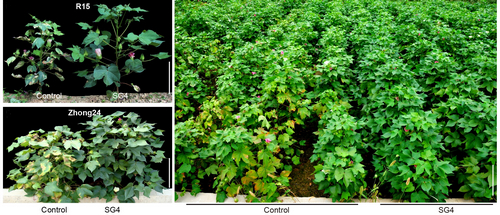China
July 18, 2016

GAFP4 transgenic cotton showed enhanced resistance to Verticillium wilt. R15 and Zhong24 are two upland cotton cultivars. SG4, GAFP4 transgenic cotton. (Image by IGDB)
Verticillium dahliae Kleb., a destructive plant pathogen, causes vascular wilt diseases on more than 400 plant species, including major crops. V. dahliae came to China through the import of cotton seeds from the United States in 1930s and then was widely spread throughout the country.
Gastrodia elata Bl. is a traditional Chinese medicinal herb. Through the study of Gastrodia antifungal protein family, which is critical to the Gastrodia elata-Armillaria mellea symbiosis, scientists from CHU Chengcai’s group at the Institute of Genetics and Developmental Biology (IGDB) of Chinese Academy of Sciences has brought GAFPs (also known as gastrodianin) into cotton. They showed that GAFP4, one of the GAFP members, displays the strongest Verticillium wilt resistance.
In collaboration with scientists from Chinese Agricultural Academy of Sciences, the researchers further demonstrated that the GAFP4 transgenic cotton greatly enhanced resistance to Verticillium wilt in the 3-year field trials of three different disease nurseries across China, resulting in a significant 20.7% to 51.73% fiber yield increase.
The immense losses caused by V. dahliae make this pathogen the major obstacle to cotton production. However, disease control towards Verticillium wilt is extremely difficult. For one reason, V. dahliae is persistent in the soil and can survive for more than 10 years even in the absence of hosts. For another, no fungicide so far is available to cure commercial upland cotton once infected by V. dahliae.
All attempts at breeding cultivars with high resistance to Verticillium wilt have not been successful so far. Breeding of broad-spectrum resistant cultivars is considered to be one of the most effective approaches. Unfortunately, the lack of genetic resources as well as effective target genes for use in genetic engineering strongly limited this breeding effort. Verticillium wilt is thus regarded as ‘the cancer of cotton’.
"Our results suggest that GAFP4 is a powerful candidate for genetic engineering in control of cotton Verticillium wilt disease.” said Dr. WANG Yiqin, the first author of the paper.
This study entitled was published online in Molecular Plant.
This work is supported by Transgenic Plant Research of the Ministry of Agriculture of China and National Natural Science Foundation of China.